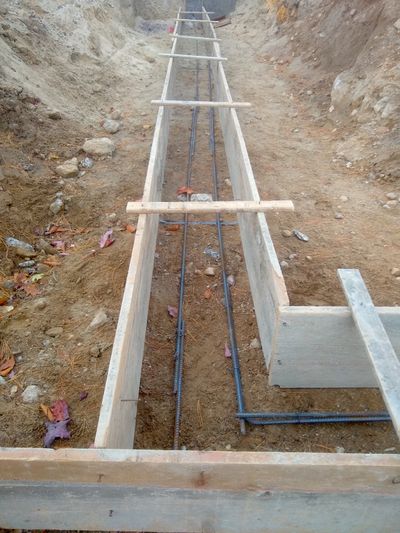Ask the Builder: Do you need steel in concrete?

Q. Tim, I’m flummoxed. I’m about to build a large detached garage. The plans call for a 10-inch-thick by 20-inch-wide poured concrete footing with two ½-inch steel bars that run continuously in the concrete. One bidding contractor says this steel is a waste of time and money, while another suggests I upgrade to ⅝-inch steel reinforcing rods.
Who’s right? What would you do? What does the steel do? How would you install it if this was your job? I don’t want to make a bad decision here. – Sandra P., Ann Arbor, Mich.
A. It’s pretty easy to get flummoxed about countless things in residential construction. You can verify this by just reading all the incoming questions I get on my Ask Tim page at askthebuilder.com. Not only do homeowners suffer from confusion, but I also see builders perplexed by all sorts of things.
Less than two years ago, an insulation contractor with more than 20 years of experienced admitted to me he had been installing insulation wrong his entire career once I pointed out his mistake.
To understand the benefit of reinforcing steel in concrete, you first need to grasp the physical properties of poured or cast concrete. Back in the mid-1990s, I was invited to an enlightening two-day editors’ conference hosted by the Portland Cement Association. From an educational standpoint, it was absolutely the best conference of my career.
I was the only member of the media in attendance who had any hands-on construction experience, but even so I discovered much about concrete and reinforcing steel I had never known before.
Concrete is artificial rock. It’s an extremely complex topic, and books and careers have been devoted to just the science of concrete. But concrete shares something in common with most natural stone. When mixed and placed correctly, concrete is extremely strong in compression. It can take thousands of pounds of pressure per square inch before shattering or cracking.
But concrete only has about one-tenth the strength in tension that it has in compression. Tension is a bending force. Put a wood toothpick in your hands and snap it in half. That’s tension: You’re bending the wood until it fails.
On a microscopic scale, however, one side of the toothpick is in tension as it’s stretching, but the other side is being compressed. This fact is important with respect to the placement of reinforcing steel.
Steel is a magical building material, especially the round reinforcing steel rods you might see on a construction site. These steel rods are easy to work with, and they have incredible tensile strength.
The average steel reinforcing rods might require 40,000 pounds of pulling force before you rip a piece of it in half. You can purchase steel reinforcing rods that even have a rating of 60,000 pounds.
At the PCA editors’ conference, the scientists demonstrated this. Before the conference, they had created some very small concrete beams that measured about 1½ inches wide, ¾-inch thick and about 16-inches long, if my memory is correct.
One bar had no steel, while the other one was reinforced with two long pieces of coat hanger steel. Both concrete bars had been created a month before the conference and had cured under perfect lab conditions. They were as strong as you could get them.
The scientists put the first bar on two pieces of 2-by-4 to simulate a miniature bridge. This bar had no steel. They then placed a small 1-pound weight in the center of the span slowly and carefully. Within seconds, the bar cracked and the bridge collapsed.
Next, they did the same with the bar that had the two coat hanger wires in it. They added 1 pound, then 5 more pounds in the center, and then (if I recall correctly) another 5 pounds, and finally the beam had a significant bend in it, but it had not shattered.
This is all you need to know about why you should always put reinforcing steel in concrete.
The placement of the steel is very important. In a footing, you want the steel in the lower third or so of the concrete. If the footing fails because of poor soil, it’s going to want to stretch along the bottom of the footing while the top is being compressed.
Thus, in Sandra’s footing, it would be wise to have about 3½ inches of concrete under the steel bars.
This same practice should be followed for poured foundation walls. You’d want two rows of steel bars about 1 foot from the top of the wall and 1 foot from the bottom.
Foundation walls can have tension happen at the top and the bottom of the wall depending on where the soil below the long walls might fail.
It’s not a bad idea to upsize the steel to ⅝-inch, especially in the footing. The ½-inch bars would work just fine in a standard poured foundation wall. But no matter what, always default to what the plans say to do.
If you have any questions, always reach out to a residential structural engineer for the answers. They’re my go-to source.
Subscribe to Carter’s newsletter at askthebuilder.com.